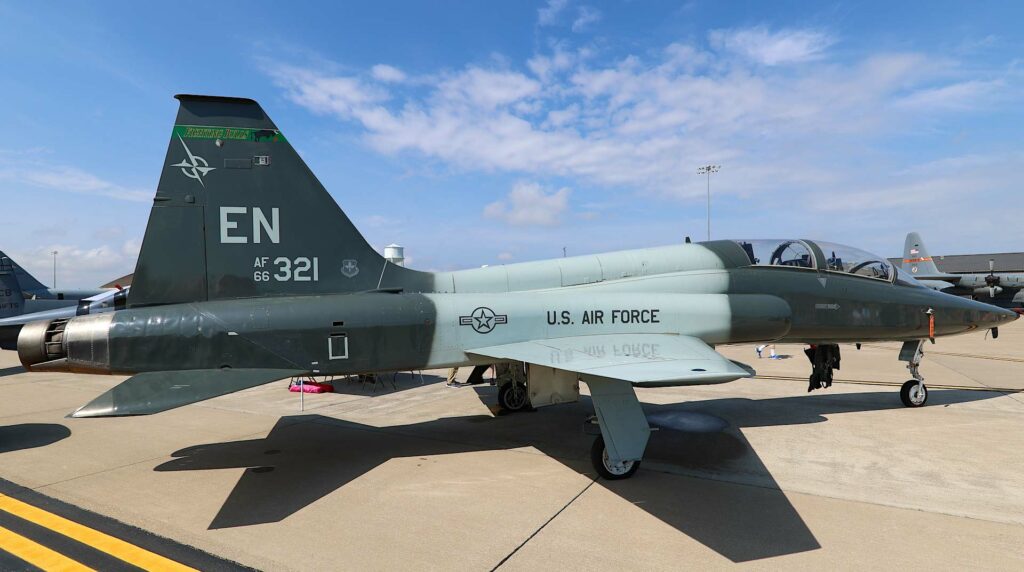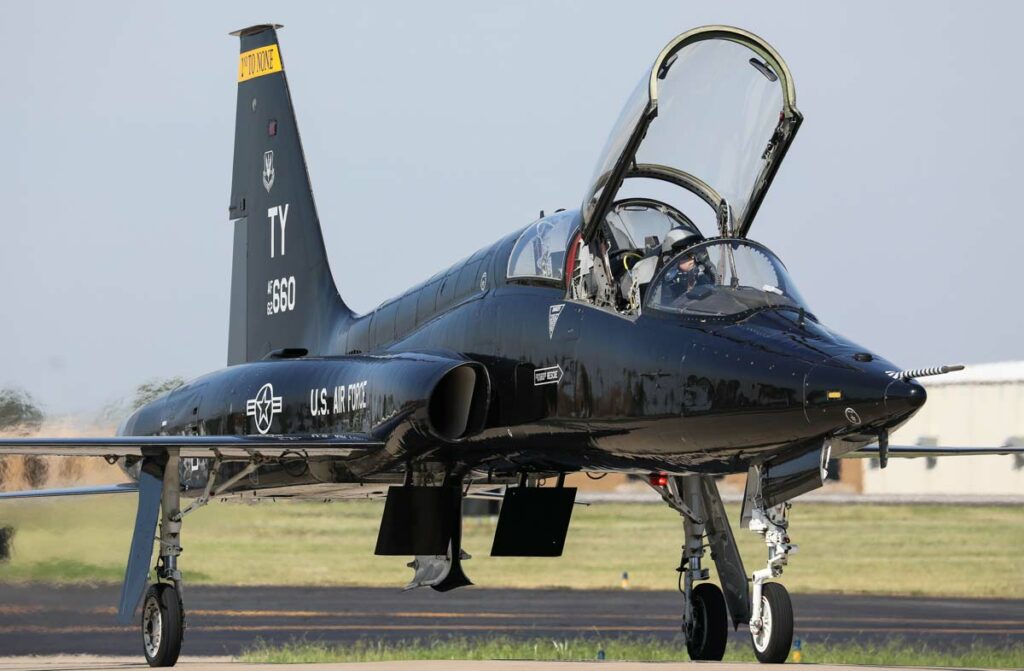The Northrop T-38 Talon is a supersonic jet trainer, known for its role in pilot training for the USAF.
In brief
The Northrop T-38 Talon is a twin-engine, high-altitude, supersonic jet trainer used by the United States Air Force (USAF). Introduced in 1961, it was the first supersonic trainer and has been instrumental in training generations of military pilots. The T-38 is powered by two General Electric J85-GE-5 turbojet engines, has a top speed of Mach 1.3 (858 mph, 1,381 km/h), a range of 1,093 miles (1,760 km), and a service ceiling of 50,000 feet (15,240 meters). Its design features include a sleek, aerodynamic frame, tandem seating, and relatively simple maintenance requirements, making it a cost-effective training solution.

History of the Development of the Northrop T-38 Talon
In the late 1950s, as jet technology advanced rapidly, the USAF identified a growing need for a supersonic jet trainer that could prepare pilots for the latest generation of fighter and bomber aircraft. This led to the development of the Northrop T-38 Talon, designed to offer high-performance training with the agility and speed of contemporary combat aircraft.
The program was launched by Northrop Corporation, with the objective of creating a versatile, efficient, and high-speed trainer that could simulate the flight conditions of much larger and more powerful aircraft. The T-38 first flew on April 10, 1959, marking a significant milestone in military aviation training.
The T-38 did not receive a specific NATO nickname, as it was primarily used within the United States and by select allied nations under military assistance programs. The aircraft was designed with a dual role in mind: to provide advanced pilot training in high-speed jet operations and to serve as a lead-in trainer for pilots transitioning to front-line tactical aircraft, such as fighters and bombers.
Design of the Northrop T-38 Talon
The design of the T-38 Talon is characterized by its sleek, lightweight construction and focus on performance and agility. Measuring 46 feet 4 inches (14.1 meters) in length and with a wingspan of 25 feet 3 inches (7.7 meters), the T-38’s airframe is optimized for supersonic speeds. Its power comes from two General Electric J85-GE-5 turbojet engines, each producing 3,850 pounds of thrust, enabling the aircraft to reach speeds up to Mach 1.3.
One of the Talon’s key design features is its tandem-seat configuration, which places the instructor and student pilot in a line, allowing both occupants to experience the same flight conditions. This setup is ideal for training purposes, as it facilitates communication and instruction during flight operations.
The T-38’s design simplicity extends to its maintenance requirements, offering operational efficiency and cost-effectiveness. However, its focused role as a trainer means it lacks the versatility and multi-role capabilities of more modern aircraft. Despite this, the T-38’s performance and reliability have made it a lasting tool in pilot training programs.
Performance of the Northrop T-38 Talon
The T-38 Talon’s performance metrics are impressive for a training aircraft. It can achieve a top speed of Mach 1.3 (858 mph, 1,381 km/h), with a service ceiling of 50,000 feet (15,240 meters) and a range of 1,093 miles (1,760 km). These capabilities enable it to effectively simulate the flight conditions of much larger and faster combat aircraft, providing pilots with a realistic training environment.
Compared to its contemporaries, such as the Soviet Yakovlev Yak-130 or the Italian Aermacchi MB-339, the T-38 holds its own in terms of speed and agility, making it a competitive option for advanced pilot training. Its longevity and continued use underscore its effectiveness in fulfilling its training role.
Variants of the Northrop T-38 Talon
The T-38 has seen several variants over its service life, including:
- T-38A: The original production model used for pilot training.
- T-38B: Equipped with enhanced navigation and weapon training capabilities.
- AT-38B: Modified from the T-38A for advanced weapons training.
- T-38C: An upgraded version with modern avionics, including a head-up display (HUD) and integrated avionics systems for advanced training scenarios.

Military Use and Combat of the Northrop T-38 Talon
Primarily used for training, the T-38 has not been employed in combat roles. Its mission has been to prepare pilots for operational aircraft, including fighters like the F-15 and F-16, and bombers such as the B-1B. The T-38’s role in developing pilot proficiency and readiness cannot be overstated, contributing significantly to the effectiveness of the USAF and other services worldwide.
The aircraft has also been sold to allied countries, enhancing international pilot training programs. It remains in use by the USAF, NASA, and other air forces around the world, testament to its enduring value as a training tool.
The Northrop T-38 Talon represents a significant achievement in military aviation, setting a high standard for jet trainer aircraft. Its design, performance, and versatility have made it an essential component of pilot training programs for over six decades. Despite the emergence of newer training aircraft, the T-38 continues to serve as a benchmark for supersonic training, illustrating the lasting impact of its innovative design and engineering.
Back to the Trainers section.